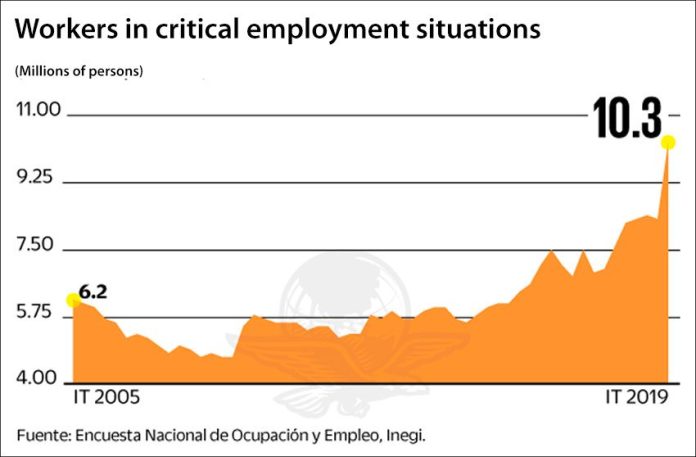Unemployment rose to its highest level in two years in the first quarter of 2019, while more than 10 million Mexicans with jobs are in a precarious employment situation, according to the National Statistics Institute (Inegi).
Just under 1.9 million people were unemployed at the end of March, an increase of more than 170,000 compared to the same month a year earlier. The unemployment rate increased to 3.5%, Inegi said.
Héctor Magaña, a professor and researcher at the Tec. de Monterrey university in México state, said that government layoffs and adjustments in certain areas of the private sector contributed to the higher unemployment rate.
Tabasco had the highest jobless rate, with 7.6% of the population of working age people unemployed, followed by Mexico City, with a rate of 4.7%; Durango, 4.6%: México state, 4.3%; and Coahuila and Sonora, both 4.2%.
Guerrero, Morelos and Oaxaca had the lowest unemployment rates, with just 1.8% of people in each state unemployed. Yucatán, San Luis Potosí and Michoacán followed with rates of 1.9%, 2.1% and 2.3% respectively.
In addition to the unemployed, Inegi said that there are a record 10.3 million people – 19% of the total working population – who are either underemployed or work regular or long hours but earn very low to low salaries, making their employment situation critical.
The cohort includes people who work less than 35 hours a week even though they want to work more, full-time workers earning less than the minimum wage (around US $160 per month) and employees whose salaries are below the equivalent of two minimum wages despite working more than 48 hours a week.
The states with the highest percentage of workers enduring critical employment conditions are: Chiapas, 42%; Oaxaca, 28%; Tlaxcala, 27%; Veracruz, 26%; Guerrero, 26%; and Baja California, Tamaulipas and Campeche, 25%.
An additional 27.8 million employees, or just over half of all Mexican workers, earn between one and two monthly salaries. As they work regular hours, their employment situation is not considered precarious by Inegi.
The percentage of people earning between three and five minimum salaries – the latter is 15,400 pesos or about US $800 a month – declined by 30% in the first quarter of 2019, statistics show, meaning that 6.3 million employees, or 11.6% of the working population fall into that bracket.
José Luis de la Cruz, director of the Institute for Industrial Development and Economic Growth (IDIC), said that a slowing of the economy is limiting the possibility of people finding well-paid jobs and working as many hours as they would like.
He said that employment in the service sector rose in the first quarter but those jobs typically don’t pay well.
“Some workers live on tips because their salaries are [so] low . . .” de la Cruz said.
Others are forced to move into in Mexico’s gargantuan informal economy.
Statistics show that the informal sector grew by 2.7% in the first quarter and now employs 30.8 million people, or 56.9% of all Mexican workers.
At his morning press conference today, President López Obrador rejected the Inegi employment figures, asserting that they are incorrect because they don’t take into account jobs created by the government’s apprenticeship and agricultural schemes.
“I have information that there are currently more job opportunities . . . For example, there are 500,000 young people that are in the Youths Building the Future program and 200,000 planters,” he said.
Source: El Universal (sp), Forbes México (sp), Milenio (sp)
